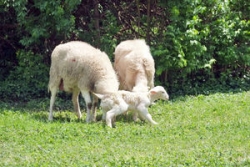Sheep give birth during Elmwood ceremony
Richmond Register | April 22, 2015 | by Machaela Ballard, Register News Writer
Spectators anticipated seeing honeysuckle-eating sheep introduced to Elmwood Estate on Wednesday, but they probably didn’t expect a lamb to be introduced to the world during the ceremony.
Not long after the first lamb was born, another arrived.
The sheep were brought to Elmwood, now owned by Eastern Kentucky University, to naturally remove invasive plant species that have taken over the lawn. However, the 10-mile ride from EKU’s Meadowbrook Farm near Waco may have pushed two pregnant, hungry sheep into labor, said Ted Herr, a junior agriculture major heading the project.
Herr faced a crowd originally gathered to hear about the targeted grazing of purebred Katahdin sheep, but two sheep giving birth stole the show.
“I was worried we would have to cancel because of the weather,” he said, “but it looks like the sheep had other plans.”
Two tiny hooves were visibly emerging from the bleating sheep as Herr continued his presentation. A fuzzy alpaca used to protect the herd called back repeatedly to the mother sheep in what seemed almost an encouraging chant.
As Herr described the many advantageous traits of the Maine-bred sheep, many aah’s rose from crowd that broke into cheers as EKU’s first Katahdin Earth Day lamb was born.
University President Michael Benson proclaimed the tiny male lamb as “the newest member of the Colonel family.”
Katahdin sheep were chosen for the project in part because of their low-maintenance. And the mother needed virtually no help during the birth. However, a second laboring sheep helped clean the lamb soon after it was born. After the ceremony, she gave birth to her own lamb.
The sheep will regularly return to Elmwood, Herr said, to strip Japanese honeysuckle, euonymus and winter creeper of leaves and flowers. Removal of vegetative matter will weaken the vines, helping EKU Facilities Services remove the stumps of undesirable plants.
Herr is completing the project as an independent study. He hopes to develop records to learn about herd productivity and “other factors of the sheep industry,” he said.
But sheep were not the only spectacle during Herr’s program.
Although they may not look like guard animals, alpacas will step between the sheep and any predators, Herr said. Alpaca spit a lot and can deliver a punishing, or even lethal, kick to an attacking dog or coyote, he explained.
Immediately after Herr finished his statement, an alpaca went into a sneezing fit.
“Just like that,” Herr said, laughing.
Read more from The Register...
Published on April 22, 2015
